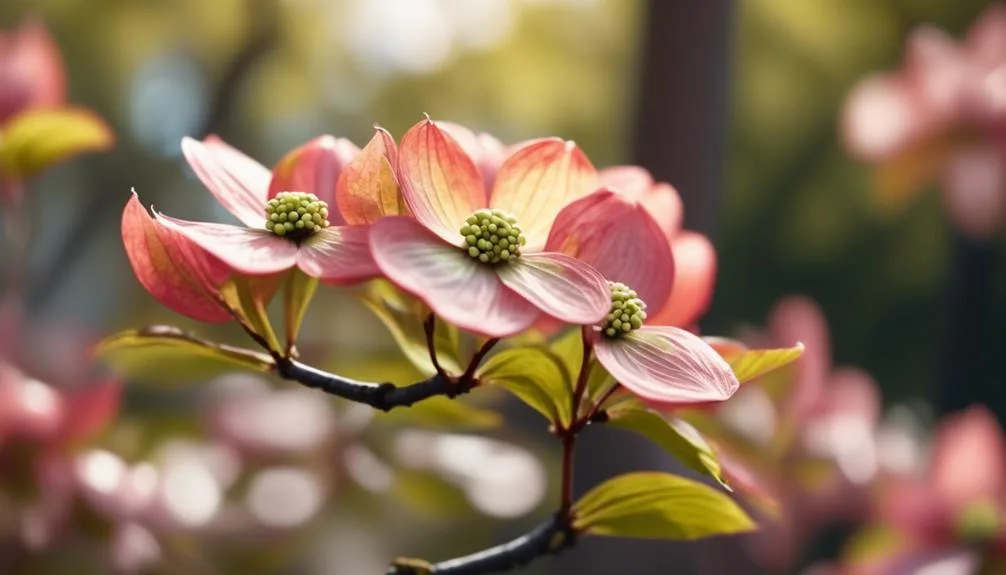Flowering dogwood trees, known for their beautiful white or pink blooms in spring, face certain diseases but also have natural resistance to others. Understanding what makes them resilient can help ensure these beloved trees stay healthy in your yard.
How dogwood trees resist diseases is a topic worth exploring to better care for them.
Disease Resistance of Dogwood Trees
Dogwood trees exhibit impressive disease resistance, making them a resilient and low-maintenance addition to any garden or landscape. This resistance is due to a combination of genetic predisposition and environmental factors.
Some dogwood species have a natural genetic predisposition that makes them less susceptible to diseases, such as the Kousa and Cornelian cherry dogwoods. Additionally, environmental factors play a significant role in disease resistance. Dogwood trees thrive in well-drained soil with adequate air circulation and sunlight. When these environmental conditions are met, the trees are better equipped to fend off diseases.
Understanding the genetic predisposition and environmental factors that contribute to disease resistance in dogwood trees can help gardeners and landscapers make informed decisions when selecting and caring for these beautiful and resilient plants.
Common Diseases Affecting Dogwood Trees
When cultivating dogwood trees, it's essential to be aware of the common diseases that can affect them. Two significant issues that dogwood trees often face are fungal infections and bacterial blight. These diseases can cause severe damage if not identified and managed promptly.
| Disease | Symptoms | Management |
|---|---|---|
| Fungal Infections | Leaf spots, powdery mildew, anthracnose | Prune affected areas, improve air circulation |
| Bacterial Blight | Leaf and flower blight, stem cankers | Prune affected areas, avoid overhead watering |
Fungal infections, such as leaf spots and powdery mildew, can be managed by pruning affected areas and improving air circulation around the tree. Bacterial blight, characterized by leaf and flower blight, as well as stem cankers, can be controlled by pruning affected areas and avoiding overhead watering. Being vigilant and taking proactive measures can help protect dogwood trees from these common diseases.
Strategies for Preventing Disease in Dogwood Trees
To maintain the health of your dogwood trees and prevent common diseases, implementing effective strategies is pivotal. Consider the following key strategies to prevent disease and ensure the vitality of your dogwood trees:
- Pruning Techniques: Regularly prune your dogwood trees to remove dead or diseased branches, as well as to promote airflow and light penetration within the canopy. Pruning also helps in maintaining the tree's natural shape and overall health.
- Soil Health: Monitor and maintain the soil health around your dogwood trees. Ensure proper drainage to prevent waterlogging, and consider periodic soil testing to assess nutrient levels. Additionally, mulching around the base of the tree can help retain soil moisture and regulate soil temperature.
- Proper Care Practices: Implement proper watering practices, avoid mechanical injuries to the tree, and monitor for any signs of disease or pest infestations. Regular observation and care are crucial for preventing and managing potential issues.
Tips for Identifying Disease in Dogwood Trees
Survey your dogwood trees regularly for any signs of disease, such as unusual spots on leaves or abnormal growth patterns, to promptly address potential issues and maintain the health of your trees.
Look for common symptoms of dogwood diseases, including powdery mildew, leaf spot, and anthracnose. Powdery mildew appears as a white powdery substance on the leaves, while leaf spot causes dark lesions with a yellow halo. Anthracnose often leads to irregularly-shaped dead areas on the leaves.
Additionally, inspect the bark for any cankers or lesions. If you notice any of these symptoms, consider seeking professional consultation to accurately diagnose the disease and determine the best course of action.
Early identification is crucial for effectively managing and treating diseases in dogwood trees.
Management of Disease in Dogwood Trees
Regularly inspecting your dogwood trees for signs of disease is essential for maintaining their health. Once symptoms are identified, effective management strategies can help preserve the beauty and vitality of your trees. When it comes to disease management and tree care, consider the following:
- Pruning: Trim affected branches to prevent the spread of disease and promote new, healthy growth.
- Proper Watering: Ensure your dogwood trees receive adequate water, especially during dry periods, but avoid overwatering to prevent root rot.
- Fertilization: Use a balanced fertilizer to provide essential nutrients and support the tree's natural defenses against diseases.
Conclusion
In embracing proactive care and early symptom detection, dogwood trees can thrive despite susceptibility to disease. Regular monitoring and timely intervention are key to preserving their beauty and longevity.
How can we ensure the continued health and resilience of these beloved trees?

My interest in trees started when I first saw the giant sequoias in Yosemite.
I was a teenager then, and I remember thinking, “I need to learn more about this.”
That moment stuck with me.
A few years later, I went on to study forestry at Michigan Tech.
Since graduating, I’ve worked in a mix of hands-on tree care and community education.
I’ve spent over ten years helping people understand how to plant, maintain, and protect the trees in their neighborhoods.
I don’t see trees as just part of the landscape.
They are living things that make a real difference in our daily lives.
